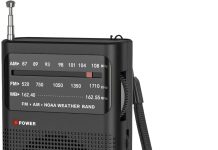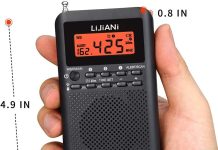Imagine you’re in the midst of a natural disaster, and all forms of communication are suddenly cut off. Scary, right? That’s where an emergency radio comes in handy, making it a must-have item for every emergency preparedness kit. But have you ever wondered how long these life-saving gadgets actually last before they need to be replaced? In this article, we’ll explore the typical lifespan of emergency radios and give you some helpful tips on getting the most out of your device. So, grab a cup of tea, sit back, and let’s dive into the world of emergency radios, shall we?
Review contents
Factors Affecting the Lifespan of an Emergency Radio
When it comes to the lifespan of an emergency radio, several factors come into play. Understanding these factors can help you determine the longevity of your radio and make informed decisions when purchasing a new one. The four main factors that can influence the lifespan of an emergency radio are the quality of the radio itself, battery life, usage frequency, and environmental conditions.
Quality of the Radio
The quality of the emergency radio plays a significant role in its lifespan. Higher-quality radios are designed with durable materials and are built to withstand challenging conditions. When considering the build quality of a radio, look for rugged construction that can withstand drops and impacts. A well-built radio is less likely to break or malfunction, making it last longer.
In addition to build quality, brand reputation is another important factor to consider. Established brands often have a reputation for producing reliable and durable products. Researching and choosing a radio from a reputable brand can increase the likelihood of a longer lifespan for your emergency radio.
To get a better idea of the durability and reliability of a specific emergency radio model, reading reviews and ratings can provide valuable insights. Real-life experiences shared by other users can give you an indication of how long a radio is expected to last under normal usage conditions.
Battery Life
Battery life is another crucial factor to consider when evaluating the lifespan of an emergency radio. The type of battery, its capacity, and the radio’s power consumption all contribute to how long the radio can function before needing a replacement.
Different emergency radios may have different battery types, such as rechargeable or disposable batteries. Rechargeable batteries are more environmentally friendly and can be cost-effective in the long run. However, their lifespan can be affected by how frequently they are charged and discharged. Disposable batteries, on the other hand, may have a shorter overall lifespan but can be easily replaced when necessary.
The battery capacity also affects how long an emergency radio can operate. Higher capacity batteries can provide longer usage times before needing to be replaced or recharged. It is important to check the manufacturer’s specifications for battery capacity and consider your intended usage requirements when selecting a radio.
Additionally, the power consumption of the emergency radio itself impacts the battery life. Some radios have power-saving features, such as an automatic shut-off after a period of inactivity, which can help conserve battery power. Understanding the power consumption of a radio model can help you estimate how long the battery will last before needing replacement.
Usage Frequency
The frequency of use is another factor that affects the lifespan of an emergency radio. The more frequently the radio is used, the faster it may wear out or experience issues. Understanding the different levels of usage frequency can help you determine how long your emergency radio is likely to last.
For individuals who use their emergency radio on a daily basis, such as for regular outdoor activities or monitoring weather conditions, the radio may experience more wear and tear. Continual use can put strain on various components of the radio, including buttons, knobs, or internal circuitry. Over time, this can lead to malfunctions or decreased performance.
Occasional usage, such as using the emergency radio during camping trips or other infrequent outdoor activities, may result in a longer overall lifespan for the radio. With proper care and maintenance, an emergency radio used occasionally can last for many years before needing replacement.
Some individuals may choose to keep an emergency radio purely for emergency situations. In this case, the radio may remain unused for long periods. While this can extend the overall lifespan of the radio, it is still important to perform regular checks to ensure the radio is in working condition when needed. Infrequent use can still result in battery drain or other issues, so it is advisable to test the radio periodically to ensure its reliability during emergencies.
Environmental Conditions
The environmental conditions in which the emergency radio is used or stored can have a significant impact on its lifespan. Understanding how factors such as temperature, humidity, exposure to water and dust, and physical impact can affect the radio can help you take appropriate measures to protect it.
Extreme temperatures and high humidity can be detrimental to the components of an emergency radio. Excessive heat can cause the internal circuitry to overheat and malfunction, while extreme cold can affect the battery’s performance. It is best to avoid exposing the radio to extreme temperature conditions and store it in a moderate climate whenever possible.
Water and dust can also damage the internal components of an emergency radio. Exposure to water can cause corrosion or short circuits, rendering the radio inoperable. Dust accumulation can affect the performance of buttons and switches, leading to malfunctions. Taking precautions to protect the radio from water and regularly cleaning away dust can help prolong its lifespan.
Physical impact, such as dropping or bumping the radio, can cause internal damage to the components. While some radios are designed to withstand moderate impacts, repeated or severe impacts can compromise their functionality. It is always advisable to handle the emergency radio with care and avoid subjecting it to unnecessary physical stress.
Signs Indicating the Need for Replacement
Over time, an emergency radio may show signs that it needs to be replaced. Being aware of these signs can help you avoid relying on a malfunctioning radio during emergencies and ensure your safety.
One of the most obvious signs that a radio needs replacement is a lack of power. If the radio fails to turn on or does not hold a charge for a reasonable amount of time, it may be time for a replacement. Batteries losing their capacity to hold a charge can lead to decreased battery life and overall radio performance.
A second sign that indicates the need for replacement is poor signal reception. If you notice a significant decrease in the radio’s ability to pick up signals or a decline in the quality of reception, it may be a sign of internal issues that cannot be easily repaired. In such cases, it is advisable to replace the radio with a more reliable model.
Physical damage to the radio, such as cracked casing, broken buttons, or loose connections, is another clear indication that a replacement is needed. While minor cosmetic damage may not affect the radio’s functionality, severe damage can compromise its reliability. If the physical integrity of the radio is compromised, it is best to invest in a new one to ensure proper performance during emergencies.
Maintenance to Extend the Lifespan
Performing regular maintenance on your emergency radio can help extend its lifespan and ensure optimal performance. Here are some maintenance practices you should consider:
- Regularly check and replace batteries as needed to maintain optimal power capacity.
- Clean the radio’s exterior and interior components to remove dust and debris that can affect performance.
- Store the radio in a protective case or bag to prevent physical damage and exposure to environmental elements when not in use.
By taking the time to properly maintain your emergency radio, you can ensure it remains in good working condition for an extended period.
Manufacturer Recommendations for Replacement
Each manufacturer may have their own guidelines or recommendations regarding the lifespan of their emergency radios. It is essential to review the manufacturer’s suggestions to ascertain when replacement is necessary. Manufacturer recommendations can provide valuable insights into the expected lifespan of the radio and inform your decision-making process.
Some manufacturers may provide an estimated lifespan for their emergency radios based on average usage patterns. This information can help you assess the longevity of a specific model and determine if it aligns with your needs. Additionally, the manufacturer may offer information on newer models that offer upgrades or improvements over previous versions.
Choosing a replacement model should consider your usage requirements, desired features, and the manufacturer’s recommendations. By aligning these factors, you can select a radio that is likely to meet your needs and last for an extended period.
Warranty Coverage and Replacement Policies
Understanding the warranty coverage and replacement policies offered by the manufacturer is crucial when it comes to emergency radios. Warranties vary between brands and models, so it is essential to carefully review the terms and conditions specific to your radio.
Some manufacturers offer limited lifetime warranties on their emergency radios, providing peace of mind for an extended period. This coverage can protect against manufacturing defects or malfunctions that may arise during the radio’s expected lifespan. In the event of such issues, the manufacturer may offer repair or replacement options.
It is also important to be familiar with the return and replacement processes outlined by the manufacturer. Understanding the steps involved in returning a faulty radio or requesting a replacement can help you navigate the process smoothly.
By knowing the warranty coverage and replacement policies, you can make informed decisions regarding your emergency radio and maximize the value you receive from your purchase.
Longevity of Different Emergency Radio Types
Different types of emergency radios have varying lifespans based on their design and power source. Understanding the longevity of each type can assist you in selecting the most suitable option for your needs.
Hand-crank radios are known for their durability and longevity. These radios are designed to be manually powered by turning a crank, eliminating the need for batteries or a reliable power source. Hand-crank radios can last for many years with proper care and maintenance, making them a popular choice for emergency preparedness.
Solar-powered radios rely on solar panels to generate power. These radios have a long lifespan as long as the solar panels are kept in good condition and receive sufficient sunlight. While the lifespan of the internal components may be similar to other radios, the ability to recharge using solar power can greatly extend the overall usage time.
Battery-powered radios, whether they use disposable or rechargeable batteries, have varying lifespans based on the factors discussed earlier. The quality of the radio, battery type, and usage frequency all contribute to how long a battery-powered radio will last. Understanding these factors can help you select a battery-powered radio with a lifespan that meets your requirements.
In conclusion, the lifespan of an emergency radio is influenced by various factors. The quality of the radio, battery life, usage frequency, and environmental conditions all play important roles in determining how long a radio will last before needing replacement. By considering these factors, performing regular maintenance, and following manufacturer recommendations, you can ensure your emergency radio remains reliable and functional when you need it most.





























